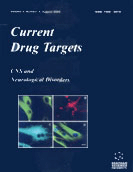Abstract
With the use of chlorpromazine and other traditional antipsychotics for psychosis, it was soon discovered that the antipsychotic efficacy of this class of medications was closely associated with their ability to block dopamine D2 receptors in the brain. This prompted the hypothesis that the etiology of schizophrenia and other psychotic illnesses might be caused by a dysregulation of dopamine. This hypothesis, that the dopamine system explains schizophrenia symptoms, however, is far from complete and the treatment with conventional antipsychotic medications is far from ideal. There has been a great deal of speculation regarding the role of serotonin receptor antagonism in regards to antipsychotic effects. The second generation antipsychotics (SGAs), clozapine, risperidone, olanzapine, quetiapine and ziprasidone all have relatively high serotonin to dopamine binding ratios. Serotonin receptor binding may be important to these drugs actions, possibly by stimulating dopamine activity in mesocortical pa thways. Yet, while the mechanism of action of SGAs as a group remain unsolved, it is important to note that the SGAs offer many clinical benefits to treatment as compared to traditional antipsychotics and are quickly emerging as first-line therapy for schizophrenia. In addition to lower rates of EPS and tardive dyskinesia, other benefits to treatment with this class of antipsychotics include better treatment of negative symptoms, better compliance, possible benefits for cognitive impairments, lower rates of relapse and rehospitalization, and more cost-effective therapy. Within the class of SGAs, however, differences exist both in efficacy and side effects and these will be described. Optimization of treatment and understanding the exact mechanism of action of current antipsychotic medications will help pave the way for new drug targets in the future.
Keywords: antipsychotic treatment, schizophrenia, antipsychotics, clozapine, risperidone, quetiapine, ziprasidone, olanzapine
Current Drug Targets - CNS & Neurological Disorders
Title: Current Status of Antipsychotic Treatment
Volume: 1 Issue: 2
Author(s): Robert R. Conley and Deanna L. Kelly
Affiliation:
Keywords: antipsychotic treatment, schizophrenia, antipsychotics, clozapine, risperidone, quetiapine, ziprasidone, olanzapine
Abstract: With the use of chlorpromazine and other traditional antipsychotics for psychosis, it was soon discovered that the antipsychotic efficacy of this class of medications was closely associated with their ability to block dopamine D2 receptors in the brain. This prompted the hypothesis that the etiology of schizophrenia and other psychotic illnesses might be caused by a dysregulation of dopamine. This hypothesis, that the dopamine system explains schizophrenia symptoms, however, is far from complete and the treatment with conventional antipsychotic medications is far from ideal. There has been a great deal of speculation regarding the role of serotonin receptor antagonism in regards to antipsychotic effects. The second generation antipsychotics (SGAs), clozapine, risperidone, olanzapine, quetiapine and ziprasidone all have relatively high serotonin to dopamine binding ratios. Serotonin receptor binding may be important to these drugs actions, possibly by stimulating dopamine activity in mesocortical pa thways. Yet, while the mechanism of action of SGAs as a group remain unsolved, it is important to note that the SGAs offer many clinical benefits to treatment as compared to traditional antipsychotics and are quickly emerging as first-line therapy for schizophrenia. In addition to lower rates of EPS and tardive dyskinesia, other benefits to treatment with this class of antipsychotics include better treatment of negative symptoms, better compliance, possible benefits for cognitive impairments, lower rates of relapse and rehospitalization, and more cost-effective therapy. Within the class of SGAs, however, differences exist both in efficacy and side effects and these will be described. Optimization of treatment and understanding the exact mechanism of action of current antipsychotic medications will help pave the way for new drug targets in the future.
Export Options
About this article
Cite this article as:
Conley R. Robert and Kelly L. Deanna, Current Status of Antipsychotic Treatment, Current Drug Targets - CNS & Neurological Disorders 2002; 1 (2) . https://dx.doi.org/10.2174/1568007024606221
| DOI https://dx.doi.org/10.2174/1568007024606221 |
Print ISSN 1568-007X |
| Publisher Name Bentham Science Publisher |
Online ISSN 1568-007X |
 3
3Related Articles
-
Anti-Inflammatory Agents in Parkinsons Disease
Anti-Inflammatory & Anti-Allergy Agents in Medicinal Chemistry Pharmacokinetics of Topical Ocular Drug Delivery: Potential Uses for the Treatment of Diseases of the Posterior Segment and Beyond
Current Drug Metabolism 3-Methyl-6-(prop-1-en-2-yl)cyclohex-3-ene-1,2-diol: the Importance of Functional Groups for Antiparkinsonian Activity
Medicinal Chemistry Genetic Anomalies of the Respiratory Tract
Current Respiratory Medicine Reviews Different Generations of Type-B Monoamine Oxidase Inhibitors in Parkinson’s Disease: From Bench to Bedside
Current Neuropharmacology Serotonin Receptor Binding Characteristics of Geissoschizine Methyl Ether, an Indole Alkaloid in Uncaria Hook
Current Medicinal Chemistry Mesenchymal Cells in the Treatment of Spinal Cord Injury: Current & Future Perspectives
Current Stem Cell Research & Therapy Molecular Effects of L-dopa Therapy in Parkinson’s Disease
Current Genomics A Genetic Dissection of Antipsychotic Induced Movement Disorders
Current Medicinal Chemistry Systematic Review of the Influence of Antipsychotics on the Blood Oxygenation Level-Dependent Signal of Functional Magnetic Resonance Imaging
Current Medicinal Chemistry Ligands and Therapeutic Perspectives of Adenosine A2A Receptors
Current Pharmaceutical Design Adenosine and ATP Receptors in the Brain
Current Topics in Medicinal Chemistry Peak Treadmill Exercise Echocardiography
Reviews on Recent Clinical Trials The Other Side of Opioid Receptor Signalling: Regulation by Protein-Protein Interaction
Current Drug Targets Noradrenaline in Parkinsons Disease: From Disease Progression to Current Therapeutics
Current Medicinal Chemistry Selective Targeting of Muscarinic Receptors: Novel Therapeutic Approaches for Psychotic Disorders
Current Neuropharmacology Imaging Endogenous Neurotransmitters In Vivo with Positron Emission Tomography Displacement Studies
Current Psychopharmacology Current Strategies for the Development of Novel Antipsychotic Drugs
Mini-Reviews in Medicinal Chemistry Caffeine as a Lead Compound for the Design of Therapeutic Agents for the Treatment of Parkinson’s Disease
Current Medicinal Chemistry Impulsive and Compulsive Behaviors During Dopamine Replacement Treatment in Parkinson’s Disease and Other Disorders
Current Drug Safety


















